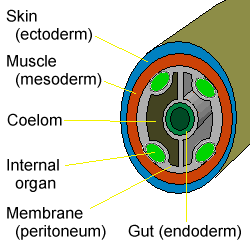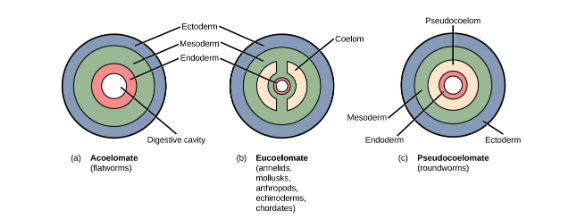MeaningStructure and TypesFunctionsFrequently Asked Questions
The coelom is one of the characteristic features of metazoans. The true coelom is a body cavity formed during embryo development from the three germinal layers. The body cavity meaning a fluid filled space that can accomodate organs. The coelom is lined by mesodermal epithelium cells. Presence or absence of coelom is one of the criteria for classifying animals.
Download Complete Chapter Notes of Animal Kingdom
Download Now
The animal kingdom is divided into three groups on the basis of the nature of coelom.

| Animal Kingdom | ||
| Acoelomate
(no coelom) |
Pseudocoelomate
(false coelom) |
Coelomate
(true coelom) |
| Porifera
Coelenterata Ctenophora Platyhelminthes |
Aschelminthes | Annelida
Arthropoda Mollusca Echinodermata Hemichordata Chordata |
Coelom Definition
“The coelom is the fluid-filled body cavity present between the alimentary canal and the body wall.”
The true coelom has a mesodermal origin. It is lined by mesoderm. The peritoneal cavity present in the abdomen and similar spaces around other organs such as lungs, heart are parts of the coelom. Coelom differs in its structure and formation process.
Structure, Formation and Types of Coelom
There are three types of structural body formation present in animals related to coelom:

1. Acoelomate:
Coelom is absent. The blastocoel is completely occupied by mesoderm. E.g. Porifera, Coelenterata and Flatworms (Platyhelminthes). There is only spongocoel or coelenteron present.
2. Pseudocoelomate:
True coelom is not present. The blastocoel is partly filled by mesodermal cells. The body cavity is lined by mesoderm only towards the body wall and mesoderm is not present towards the gut. E.g. Roundworms (Aschelminthes)
3. Eucoelomate:
Animals that have a true coelom. The coelom is lined by mesoderm on both the sides, towards the body wall and towards the gut. The blastocoel present in the gastrula gets completely replaced by a true coelom. The body organs are suspended in the coelom by mesenteries. E.g. from the phylum Annelida to Chordata.
Eucoelomates are further divided into Protostomes and Deuterostomes on the basis of different embryonic development. The process of coelom formation in protostomes and deuterostomes is different. The coelom is categorised into two types on the basis of formation, namely, Schizocoelom and Enterocoelom.

- Schizocoelom: It is present in the protostomes. The body cavity or coelom originates from the splitting of the mesoderm. One part attaches to ectoderm and the other surrounds the endoderm. The space between them develops into the coelom. The blastopore forms the mouth. Examples of schizocoelous animals are Annelida, Arthropoda and Mollusca. In Arthropoda and Mollusca the coelom is filled by blood and is known as Haemocoel.
- Enterocoelom: It is present in the deuterostomes. The coelom is formed from the fusion of the internal outgrowths of the archenteron, that pinches off and fuses together to form coelom lined by mesoderm. Examples of enterocoelous animals are Echinodermates and Chordates.
Don’t miss: NEET 2017 Question Paper with solutions and answer keys
Coelom Function
- Coelom works as a shock absorber and protects from any kind of mechanical shock. It gives more flexibility to the body organs to move and protects from any damage on minor bends by cushioning the internal organs
- The coelomic fluid acts as a hydrostatic skeleton, which helps in the locomotion of soft-bodied animals and gives the body a definite shape. Contracting muscles can push against the coelomic fluid because of the fluid pressure.
- The coelomocyte cells, that either float freely in the coelom or attached to the wall, support the immune system. They support the immune system by initiating humoral immune response and phagocytosis
- The coelomic fluid also helps in gaseous transport and transport of nutrients and waste products
- Coelom gives the extra space required by organs to develop and function. E.g. pumping action of the heart, carrying a child in the womb, etc. is possible due to coelom
Frequently Asked Questions on Coelom
What Is Coelomic Cavity?
In most animals, Coelom is the main body cavity located in the body to envelop and contain the internal organs, digestive tract etc. It is a hollow, fluid-filled cavity serving as a skeleton.
Do Sponges Have a Coelom?
No. Coelom is a body cavity where the heart, kidney, lungs etc are found therefore sealing it from the outside contact. Sponges are poriferans, they lack a coelom. Their body cavity is large, exposed to the outside enabling food consumption
Do Mollusks Have a Coelom?
Yes, molluscs have developed a true coelom. They are bilaterally symmetric and triploblastic. The coelom is an internal body cavity bound by mesodermal membranes. But, their coelom is reduced to a hemocoel – tiny void near the heart.
Do Humans Have a Coelom?
Humans are Coelomates, they possess a true coelom. Humans possess a coelom that segregates into various unconnected cavities of the body while developing. It is a cavity not found in the human adult, but in the embryonic phases which splits into other cavities.
Also See:
NEET Flashcards: The Living World
NEET Flashcards: Biological Classification
NEET Flashcards: Plant Kingdom

So interesting
👌👌👍👍😯Wow nice 👌
Wow nice
Yes very well understood 😀😀😀
Helped me a lot!🙌🏻